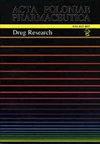Additional degradants in the impurity profile of atropine low-dose ophthalmic solution
IF 0.4
4区 医学
Q4 PHARMACOLOGY & PHARMACY
引用次数: 0
Abstract
WHO has identified the increase in myopia as the world's greatest threat to vision health due to its association with vision-threatening complications like myopic macular degeneration, retinal detachment, cataract and open angle glaucoma. Pharmacological treatment with atropine is assessed as one of the best option in op-tical approaches to the control and inhibit of myopia progression. The aim of this study was to develop analytical method for quality control of 0.1 mg/mL atropine ophthalmic solution. UPLC analytical method for simultaneous determination of atropine sulfate monohydrate and its related substances described in Eur. Ph. and for additional impurities was developed. For method development low-dose of atropine formulations with a wide range of pH 4.5-6.6 were tested and the impact of formulation pH on the impurity profile was noted. The ionized form of tropic acid was observed in our studies in all buffered formulations with pH above 5. Additionally two isomers of atropine N-oxide were observed in the tested preparation with pH 6.6 in the presence of an oxidizing agent and were just possible to integrate with our new developed UPLC method. The ionized form of tropic acid was already defined in Berton et al. publication (1) and observed in the buffered formulation with pH 6.0. Our result complement and extend the impurity profile of atropine in wider pH range of atropine ophthalmic solutions.阿托品低剂量眼科溶液杂质谱中的附加降解物
世卫组织已将近视的增加确定为世界上对视力健康的最大威胁,因为它与近视黄斑变性、视网膜脱离、白内障和开角型青光眼等视力威胁并发症有关。阿托品的药物治疗被认为是控制和抑制近视进展的最佳选择之一。建立0.1 mg/mL阿托品眼液的质量控制方法。UPLC同时测定一水硫酸阿托品及其有关物质的方法。ph和额外的杂质被开发。为了开发方法,测试了pH范围为4.5-6.6的低剂量阿托品配方,并注意了配方pH对杂质谱的影响。在我们的研究中,在pH值高于5的所有缓冲配方中观察到热带酸的电离形式。此外,在pH为6.6的测试制剂中,在氧化剂的存在下,观察到阿托品n -氧化物的两个异构体,并且正好可以与我们新开发的UPLC方法相结合。在Berton等人的出版物(1)中已经定义了热带酸的电离形式,并在pH为6.0的缓冲配方中观察到。我们的结果补充和扩展了阿托品在更大pH范围内的眼科溶液的杂质谱。
本文章由计算机程序翻译,如有差异,请以英文原文为准。
求助全文
约1分钟内获得全文
求助全文
来源期刊
CiteScore
0.80
自引率
0.00%
发文量
74
审稿时长
6-12 weeks
期刊介绍:
The international journal of the Polish Pharmaceutical Society is published in 6 issues a year. The journal offers Open Access publication of original research papers, short communications and reviews written in English, in all areas of pharmaceutical sciences. The following areas of pharmaceutical sciences are covered: Analysis, Biopharmacy, Drug Biochemistry, Drug Synthesis, Natural Drugs, Pharmaceutical Technology, Pharmacology and General.
A bimonthly appearing in English since 1994, which continues “Acta Poloniae Pharmaceutica”, whose first issue appeared in December 1937. The war halted the activity of the journal’s creators. Issuance of “Acta Poloniae Pharmaceutica” was resumed in 1947. From 1947 the journal appeared irregularly, initially as a quarterly, then a bimonthly. In the years 1963 – 1973 alongside the Polish version appeared the English edition of the journal. Starting from 1974 only works in English are published in the journal. Since 1995 the journal has been appearing very regularly in two-month intervals (six books a year). The journal publishes original works from all fields of pharmacy, summaries of postdoctoral dissertations and laboratory notes.

 求助内容:
求助内容: 应助结果提醒方式:
应助结果提醒方式:


